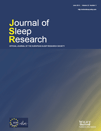The daily variation in sleepiness and its relation to the preceding sleep episode—a prospective study across 42 days of normal living
Summary
Sleepiness is linked to accidents and reduced performance, and is usually attributed to short/poor prior sleep and sleepiness. However, while the link between reduced sleep and subsequent sleepiness is well established in laboratory experiments of sleep reduction, very little is known about the day-to-day variation of sleepiness in everyday life and its relation to the immediately preceding sleep episode. The purpose of the present study was to investigate the characteristics of this relation across 42 consecutive days. Fifty volunteers participated. Self-reports of sleep were given in the morning and recorded with actigraphy; health was rated in the evening; and sleepiness was rated at eight points during the day (on a scale of 1–9). Results from mixed-model regression analyses showed that, on average, total sleep time predicted sleepiness during the rest of the day across the 42 days, with sleepiness increasing with shorter preceding sleep (β = −0.15 units h−1, P < 0.001). Sleepiness also increased with earlier time of rising and lower-rated sleep quality. Days off reduced sleepiness, but was accounted for by sleep. Self-rated health improved when sleepiness was low during the same day (β = −0.36 unit unit−1 of rated health, P < 0.001), but the two were measured simultaneously. Napping was related to high sleepiness during the same day. Actigraphy measures of sleep duration showed similar, but somewhat weaker, effects than diary measures. It was concluded that the main determinants of daytime sleepiness in a real-life day-to-day context were short sleep, poor sleep and early rising, and that days with high sleepiness ended with ratings of poorer health.




